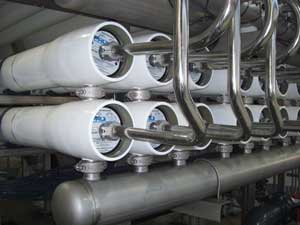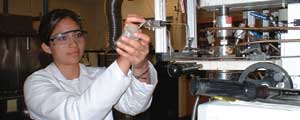August 2008
 View Full Print Edition
View Full Print EditionBusiness Briefs
Columns

IFEW Sends Positive Message
By Mike Bryan

Flooding Hits Midwest Cornfields, Ethanol Plants
By Craig A. Johnson

Natural Gas from the Ground to the Ethanol Plant
By Leanna D. Whipple

Getting a Handle on Biomass
By Rona Johnson

Facing the Challenge of Development
By Art Wiselogel

Progress in the Face of Adversity
By Jessica Sobolik
Featured

FFVs Flourish in Sweden
By Eric Kroh
The Swedish people take the environment and their need to reduce oil use seriously. That attitude is reflected in their use of flexible-fuel vehicles, which has increased from 717 in 2001 to more than 100,000 today.

The Mystery of Modularizing
By Anna Austin
A top modularizing firm, Roeslein & Associates Inc., has formed a partnership with BlueFire Ethanol Inc. to integrate its concepts into the construction of a new ethanol biorefinery. They have now opened a door into the world of renewable energy—serving as a short cut to the market.

The Role of DDGS in the Food-Versus-Fuel Debate
By Ron Kotrba
As mainstream media continues its tirade against biofuels in the food-versus-fuel debate, many aren't aware of or ignore distillers grains and how it fits into the picture.

Make Accounting Software Investment Pay Off
By Jack Mount

The Truth About Food and Fuel
By Ron Kotrba, Dave Nilles, Kris Bevill, Jessica Sobo
The 24th International Fuel Ethanol Workshop & Expo was held June 16-19 in Nashville, Tenn., in the midst of record-busting energy prices and serious charges against the industry posed by Big Oil and "Big Food."

Microbial Tricks for the Cellulosic Ethanol Trade
By Jessica Ebert
In two recently reported research projects, scientists describe how they have taken cues from microbes that may ultimately lead to more efficient and cost-competitive production of biofuels.

Connecting the Pipes
By Jessica Sobolik
Ethanol plants may vary in design, but they all need one thing: piping. There are different types of piping that connect the many processes within the facility, and each offers its own advantages. Although this equipment is essential it isn't without its challenges when it comes to labor, maintenance, safety, education and cost.

In Pursuit of Fruit
By Bryan Sims
As the food-versus-fuel debate rages, ethanol producers are searching for nonfood and food-based waste products to make renewable fuel. This has led researchers to take a closer look at watermelons that don't ripen in time for harvest or fail to make the grade for grocery store produce aisles.

The Hand That Turns the Wrench
By Timothy Charles Holmseth / Photos By Howard Pfefer
Ethanol plant technicians who are able to avoid unexpected shutdowns are like money in the bank. Instructors at the Biofuels Automation University in Plymouth, Minn., believe that with highly trained technicians and the technology available today, there should be no unscheduled downtime in an ethanol facility.

Beating Back Bad Bugs
By Jerry W. Kram
Bacterial contamination is one of the banes of ethanol production. Producers spend a considerable amount of money on sanitation and antibiotics trying to control bacteria in their fermentation tanks. A new system will not only reduce bacteria in the fermentation tanks, but also prevent re-infection. As a bonus, the new system leaves distillers grains free from antibiotic residues.

The Value of Branding
By Rona Johnson
In a growing industry having preferred status with customers is essential. A Sioux Falls, S.D., company has developed a way to help renewable energy companies define their brands and distinguish themselves among their competitors.

Where in the Northeast is E85
By Kris Bevill
One can easily drive through the U.S. Midwest and run across an E85 station before it's time to refuel. There may even be a couple different stations to choose from. Ethanol marketers in the Northeast can only dream about that kind of distribution, but they're working hard to make it a reality.

Breaking the Catalytic Barrier to Biofuels
By Jessica Ebert
Whether it's enzymes for degrading cellulose, microbes for fermenting sugars into ethanol or solid particles for the reforming of syngas to ethanol, the development of highly active and selective catalysts for biofuels production will be key to the success of the industry.

Indy's Super Fuel
By Craig A. Johnson / Photos by Craig A. Johnson
Since 2006, Indy Racing League competitors have been using ethanol to fuel their hopes for a checkered flag. Making sure that quality is never sacrificed in the process is the job of PerkinElmer Inc. EPM goes to the Milwaukee Mile to experience the power of Indy racing and to see firsthand what goes into testing the fuel for this high-octane environment.

Embracing the Carbohydrate Economy
By Susanne Retka Schill
Industry and academic research leaders share new research leads and emerging technologies for corn use at the 2008 Corn Utilization and Technology Conference.

GM Crops and Biofuels
By Jon Evans
Are European biofuels producers being disadvantaged because some countries won't allow the production or importation of genetically modified crops?

Building the Next Generation
By Bryan Sims
With the advent of cellulosic ethanol, design/build teams are gearing up for the commercialization of the next generation of biofuels, and at the same time are continuing to be involved in corn-based ethanol, where they built their reputations. EPM talked with some of the big names in the industry to get their view on this challenging transitional period.
Breaking Through to the Other Side of Biofuels
By Bryan Sims / Story & Photos
With unwavering mettle, John Rivera of Sustainable Power Corp. intends to introduce a biocrude oil product, called Vertroleum, into the global fuel supply chain. Despite its detractors, the company continues to refine what it refers to as the "Rivera Process" at its Texas demonstration facility. Biomass Magazine traveled there to see how the production process works.
From Problem to Profit
By Jerry W. Kram

Flexible Biomass Conveyance
By Ron Kotrba
The biomass gasifier at Chippewa Valley Ethanol Co. is fuel-flexible by design. Thisrequires a handling system engineered to move feedstocks of varying volumes and densities. Biomass Magazine speaks with Rapat Corp., the engineer of the bulk conveyance system, and equipment vendor Robert White Industries Inc., about the project.
Building Better Biofuels
By Diane Greer
If you were going to create the perfect biofuel, what would you make? When the founders of San Carlos, Calif.-based LS9 asked the question, their answer was quite simple, says Gregory Pal, senior director for corporate development. "You would make petroleum."

Sprucing Up Wood Waste
By Anna Austin / Photos by Elizabeth Slavens
Wood chips are commonly used as a feedstock in the biomass industry-but what processes must waste wood undergo before it is suitable for use? How is contaminated wood treated to meet standards and obey regulations? Biomass Magazine investigates the old and new processes some companies are using to clean and recycle waste wood.

Cleansing and Reforming Syngas
By Ron Kotrba
Four research alliances received grants from the U.S. DOE to optimize thermochemical biofuels production. Biomass Magazine offers an overview of those projects.

A Sweet Energy Source
By Kris Bevill / Story and Photos
A few years ago, American Crystal Sugar Co. began supplying the University of Florida with sugar beet waste for a research project that, if realized, could change the way the company does business by turning some of its waste into energy. While the project is still in the pilot-plant phase, all signs point toward a successful turnaround from waste product to green energy.

Drumming Up Demand for Diesels
By Ron Kotrba
Passenger diesels were a hard sell in the United States more than a generation ago. Even though the diesels of today are not those of yesterday, will the experience be different this time around?

From Fish Farm to Fuel
By Jerry W. Kram / Photos By Charlotte Southern
The steep rise in fuel prices is creating opportunities for entrepreneurs to innovate and discover new low-cost feedstocks for biofuels production. Neptune Industries, a Florida company, is looking to collect waste generated byits fish farming operation to fertilize algae production for biodiesel feedstocks.

Grease: Worth Its Weight in Gold?
By Kris Bevill / Story and Photos
Biodiesel producers aren't the only ones feeling the sting of high feedstock prices. As the cost of biodiesel feedstocks increases, grease thieves have started to take notice. Grease thefts are on the rise across the country.

Sustainability = People + Planet + Profit
By Susanne Retka Schill
Sustainability is an all-encompassing, hard-to-define term that is acquiring fuller meaning for the palm oil industry as it prepares to ship the first certified sustainable palm oil to European markets.

A Synergistic Pairing
By Dave Nilles
Ethanol and biodiesel have more in common than just a geographical footprint. With corn oil, the industries are edging closer to a relationship that could aid both as feedstock prices rise.
Contributions
Committed to the Next Generation of Biofuels
By Bill Eby

Overcoming Challenges in the Boardroom
By Tracy Houston and Cindy Knutson

Fuel for Thought: Protecting an Ethanol Production Business
By Scott Helmer
Treating Digester Off-Gas from Wet Mill Ethanol Production
By Kenneth D. Jones, Steve Black and Tony Barnette

Pump Technologies Provide Greater Efficiencies
By Tom Stone

The Farm Bill: Planting Seeds of Renewable Energy
By Matthew E. Ross
Energy Security Achievable with Biofuels Made in the Americas
By George Philippidis

Plant Expansion Through Membrane Integration
By Christian Roy

Green Acres is the Place to Be
By Chris Zygarlicke
A Multi-Prong Approach to Carbon Neutrality
By Stephen Paley














